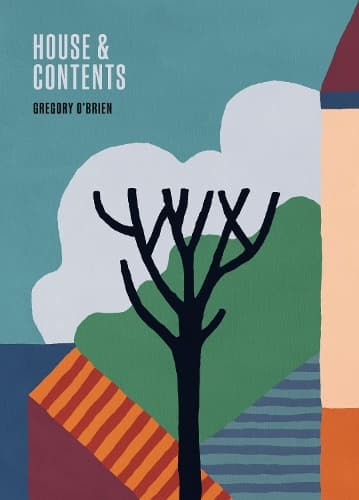Review: House & Contents
Reviewed by Harry Ricketts
Name three painter-poets. That’s the kind of question they might ask in a pub quiz or on The Chase. (“Are you clever enough?”) William Blake, Michelangelo … Dante Gabriel Rossetti … David Jones. A New Zealand contestant might win with Gregory O’Brien and/or John Pule.
The painter-poet: it’s a select category. The visual and verbal imaginations often complement each other – think of all those paintings about poems, all those poems about paintings – but the two don’t that often co-exist. O’Brien’s extremely handsome new collection, House & Contents, brings together the two modes (45 poems, 23 paintings) and encourages us to contemplate them, to read them, separately and collectively. Because O’Brien is equally adept as painter and poet, it's a rewarding experience.
On an initial reading/viewing, it is probably inevitable that the visual images, even reduced to page-size, tend to overwhelm the impact of the words. However, closer familiarity suggests some of the common ground the two activities clearly share for O’Brien. He likes, for instance, to title paintings as though they were poems or to give them poem-echoing titles. Three paintings here are called Ode to …; another, a canticle; yet another, An evening hymn. Similarly, Poem in the Matukituki Valley (I and II) recalls the title of Baxter’s famous poem, while Lines composed a few metres above high water, Meretoto recalls that of Wordsworth’s Lines composed a few miles above Tintern Abbey. his is playful; helpful, too. The paintings in O’Brien’s trademark acrylic (flat plane, vibrant but stylised) are crammed with suggestively heterogeneous objects, elements and text whose relevance and possible relationships we are invited to muse over (and perhaps interpret), as we might a poem.
Take Gurdjieff. This depicts a grey-clothed woman caught in a dance pose, standing to the left of a raised grey bed with a bell suspended above it, both set against a background of red, jagged hills, under an orange full moon (or sun). Since Mansfield died in Gurdjieff’s Institute for the Harmonious Development of Man in Fontainebleau, one way to ‘read’ the painting might be to see it as a vision of Mansfield (or her liberated spirit?) escaping in a Gurdjieffian dance from Time (the bell) and tuberculosis (the iron lung of a bed), but mindful of New Zealand and/or imaginatively back in New Zealand (those are definitely local hills). Or not.
The poems offer similarly rich opportunities and are sometimes organised in ways analogous to the paintings: lines in the sound-and-image-shifting Sixteen things, for instance: “mister cool / mystical”; “mandarin / meandering”; “anything with a moustache that is also a fish.” There’s a thread of terrific prose poems twisting through the collection. Some conjure up the successive effects of recent major earthquakes in Wellington and elsewhere: “leaves on overarching branches began vibrating, lit up by a frenetic, other-worldly light”; “milk flagons leaping from the shelves like middle-aged men going feet first into a swimming-pool”; “the frames of paintings bumping against walls as if they wanted to be let in.”
Others recall a visit to Santiago and seismic conversations with the Chilean architect/designer Cristian Valdes: “During the Pinochet years – that era of disappearances – it was as if the walls started swallowing up the population.”
Among the more ‘conventional’ poems, my favourite is the final one: For Jen at Three O’Clock, which ends, heart-turningly: “with us, a rare climbing moss, / only us”. (There are also a number of moving elegies: House, Father and especially The library ladder for the late Lydia Wevers.) As with the paintings, the ostensible subject often opens up an anthology of unexpected ideas and associations, as in Sombrereria: “A well-situated hat can be // many things: ice bucket, dormitory, a nesting place / for the tropic bird, or rocky outcrop of some / distant geography.”
One recurring pleasure is never quite knowing where a poem or painting might take you, but trusting you will want to go there, anyway. O’Brien claims in an endnote, that “It is poetry’s job to flicker and glow and, with luck, emit some mysterious luminescence.” There’s no shortage here of flicker and glow, nor of mysterious luminescence.
Reviewed by Harry Ricketts
